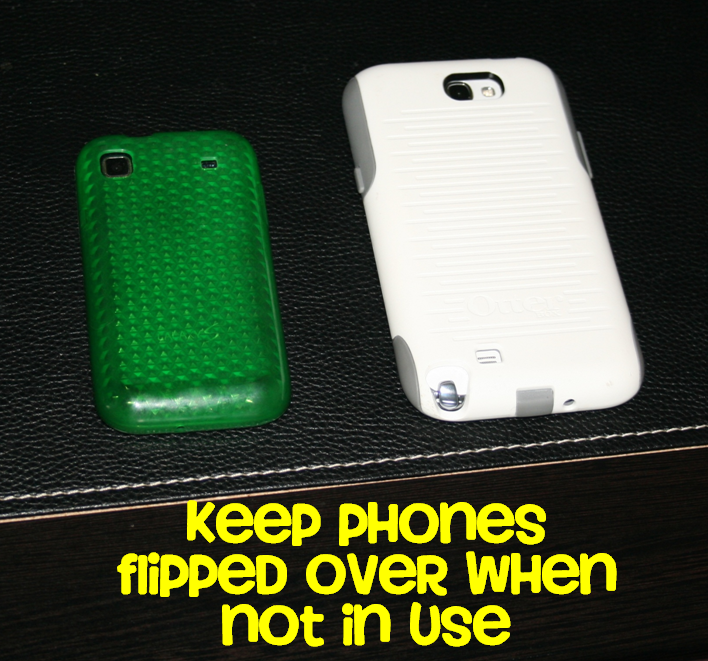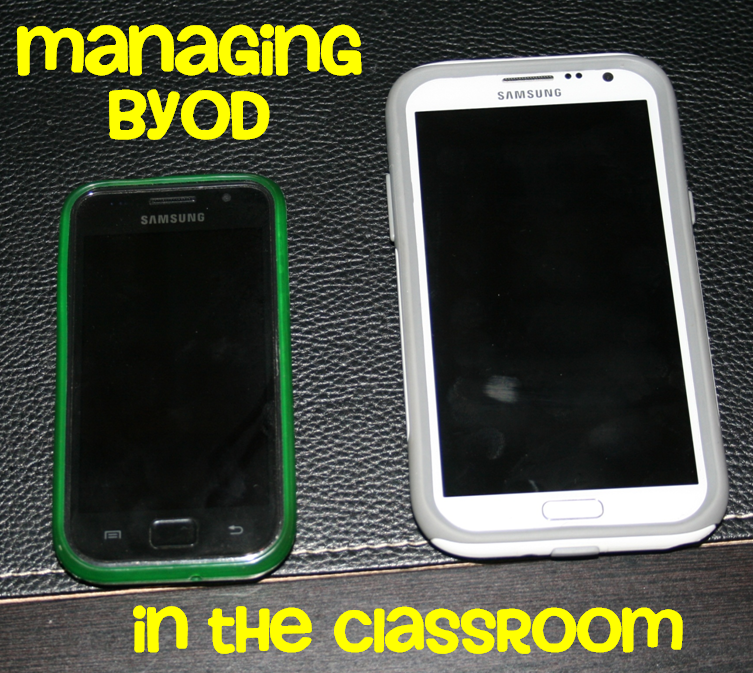
If you’ve ever considered having students bring their own devices (BYOD) to class, you’ve probably worried…won’t the kids text all day long? How do I keep them from taking inappropriate photos or posting on Facebook while I’m teaching? Aren’t students’ phones a huge distraction? Here to help is Kristy from the 2 Peas and a Dog blog. Kristy is a Canadian middle school teacher who is in her seventh year of teaching Grades 7 and 8’s. She has allowed students to bring their own technology into the classroom for a few years now, and is excited to share how BYOD works in her classroom.
The Philosophy Behind BYOD
There has been a trend in education lately for students to bring their own technological devices to school. The reasons for this trend could be:
- Funds normally spent on technology can be diverted to other expenses if students bring their own items
- Students are more familiar with their own devices versus using the school supplied ones, in theory making them more productive
- It allows instant access to information, no more waiting for a scheduled library visit to use computers or look up facts
Setting up the BYOD Classroom
The BYOD classroom requires a lot of front end planning and pre-teaching before devices can be brought into the school. As a teacher you need to have a discussion with your grade team, then your school administration to see what the policies are in your school and district.
Once you have the green light from administration you can start planning on how to integrate this BYOD technology into your classes with your students and grade team partners. Survey your students: Do they own personal technology? Are they allowed to bring it to school? Would they want to bring it to school? If the majority answer yes, then you are on your way to a BYOD classroom.
BYOD is best done with explicit teaching and within a gradual release model. Would you hand over your car keys to a new teenager without first giving them driving lessons? Don’t hand over your classroom until you have built a community of learners who will understand and respect the rules for BYOD in the classroom.
Creating technology success criteria
Before any devices are brought into the school, students take home a permission form to their parents notifying them of BYOD, its purpose (i.e. not to text your child during class time, BUT this will happen) and that the responsibility is with the child to manage, fix and ensure proper storage of the device. I use a form supplied by my school that explicitly states that the school is not responsible for lost or stolen devices, and that the devices must be stored in students lockers when not in use.
As I wait for the permission forms to be returned from interested students, we develop a list of possible devices that could be brought in (cell phones, tablets, laptops, cameras, e-readers, etc) then we create a Technology Success Criteria.
As a class we discuss what appropriate and inappropriate use of their devices looks and sounds like. Appropriate use could consist of looking up information, typing up assignment, using an online calendar to manage due dates. Inappropriate use would be texting, social media, phone calls, browsing non-school related websites.
Once the forms have been returned, I collect them and circulate a list of student names to my teaching partners of students permitted to use their own technology at school.
Managing the BYOD classroom
You must first have your classroom norms, routines and community established before you can jump into BYOD. Take time to establish co-created success criteria and co-created consequences for inappropriate use. My consequences are:
- First offense: a verbal warning/reminder
- Second offense: device goes into the student’s locker immediately
- Third offense: device gets taken away and given to the school principal
Once the school principal gets involved then your regular school policies and procedures apply. Some schools keep devices until the end of the day, others until a parent can come and pick it up.
Make sure that students silence all devices upon entry into the classroom. You are the pilot and cannot be disrupted from the flight plan (lesson plan) because X gets 100 texts a day.
Set up rules with the students about when BYOD devices can be used during the day. Students must ask my permission before they start using their device, and explain what they will be working on.
When devices are not in use (during a test or a lesson) I have students leave their devices on their desks face down. This prevents the covert in the desk usage, and helps students stay focused on their task. You could also ask them to leave the devices in their lockers when you do not want them to be used.

Q & A with Kristy
Angela here again–I always have a million questions for teachers who have found ways to make Bring Your Own Device work for them, and Kristy was kind enough to answer them all! Here’s some additional info on what works for Kristy.
Q: If students have their devices taken away, how do they complete the assignment?
A: I never assign an assignment that cannot be done on paper because we are not a 1:1 school. I only have 3 computers for 31 kids. I have kids finish their assignment on paper, or if they need it for facts etc they would use it while sitting RIGHT next to me at my guided reading table while I conference with other students.
Q: You mentioned having students silence their phones. What system do you use for helping them remember to do this or for checking to make sure it’s been done?
A: I remind them the first day, and then it is up to them to remember. However I have also seen great signs on Pinterest and TPT that remind students to use silent mode. It is part of the responsibility of having a device. Their parents put their phones on silent during work hours or meetings. If it rings – I make a joke the first time then it gets a warning etc.
Q: Does your school provide any tech for students’ use (laptops, iPads, etc.)? What kind?
A: Students in K-3 get 2 desktop computers and 2 ipads in their classrooms provided by the school. Students in 4-8 get 3 laptops per classroom provided by the school. We have one computer lab of 30 computers for 900 kids, hence BYOD is vital.
Q: Is your entire day BYOD, or are there times when students use the school’s tech only?
A: BYOD is only for grades 6-8 at my school–other grades invite students to bring in their technology a few times a year for special presentations or projects. Students in grades 6-8 are allowed to use BYOD all day, every day for educational purposes except during recess, lunch and test times.
Q: How do you decide when students are able to use their devices?
A: I start my year with success criteria and from then o,n students can use their devices freely on approved apps, etc. If they break the rules by using social media or texting, I take their phone away for the period. If it happens again it goes to the office
Thanks for reading! Kristy and I would love to hear any questions or ideas in the comments below on how you use BYOD in your classroom. You can also connect with Kristy at her 2 Peas and a Dog blog, on Pinterest, or on Facebook.
My Favorite Technology Management Resources on Pinterest

Angela Watson
Founder and Writer
Sign up to get new Truth for Teachers articles in your inbox
OR

Join our
community
of educators
If you are a teacher who is interested in contributing to the Truth for Teachers website, please click here for more information.
















